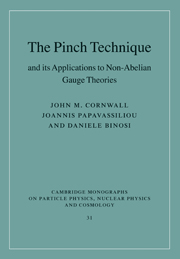Book contents
- Frontmatter
- Contents
- Introduction: Why the pinch technique?
- 1 The pinch technique at one loop
- 2 Advanced pinch technique: Still one loop
- 3 Pinch technique to all orders
- 4 The pinch technique in the Batalin–Vilkovisky framework
- 5 The gauge technique
- 6 Schwinger–Dyson equations in the pinch technique framework
- 7 Nonperturbative gluon mass and quantum solitons
- 8 Nexuses, sphalerons, and fractional topological charge
- 9 A brief summary of d = 3 NAGTs
- 10 The pinch technique for electroweak theory
- 11 Other applications of the pinch technique
- Appendix: Feynman rules
- Index
8 - Nexuses, sphalerons, and fractional topological charge
Published online by Cambridge University Press: 04 February 2011
- Frontmatter
- Contents
- Introduction: Why the pinch technique?
- 1 The pinch technique at one loop
- 2 Advanced pinch technique: Still one loop
- 3 Pinch technique to all orders
- 4 The pinch technique in the Batalin–Vilkovisky framework
- 5 The gauge technique
- 6 Schwinger–Dyson equations in the pinch technique framework
- 7 Nonperturbative gluon mass and quantum solitons
- 8 Nexuses, sphalerons, and fractional topological charge
- 9 A brief summary of d = 3 NAGTs
- 10 The pinch technique for electroweak theory
- 11 Other applications of the pinch technique
- Appendix: Feynman rules
- Index
Summary
Introduction to nexuses and junctions
So far, it may appear that center vortices are embedded Abelian objects. But center vortices can be extended to non-Abelian objects in several ways. We describe two: the first we call junctions, representing the merging and branching of vortex lines (or sheets, in d = 4) without the necessity of monopole-like objects called nexuses; the second are nexuses themselves, which are modifications of 't Hooft–Polyakov monopoles but with their magnetic flux bundled into tubes that are parts of center vortices. The most interesting property of nexuses is that, along with center vortices, they admit the formation of quantum lumps of nonintegral topological charge. Nexuses do not change the picture of confinement given in this book in any material way, although this is not completely obvious. But they enter in a crucial way into a reinterpretation of Polyakov's discussion of confinement in the d = 3 Georgi–Glashow model, as we indicate at the end of this section.
Note that we continue to use the notation of Chapter 7. All sections are in Euclidean space, except for Section 8.3.2, which is in Minkowski space.
Junctions
Junctions are thick points (d = 3) or lines (d = 4) where a vortex can branch into other vortices. It is easy to draw them in d = 3, where they look like vacuum Feynman graphs. Figure 8.1 shows a simple example with four junctions in SU(3), where three lines meet at each junction (up to N lines can meet at an SU(N) junction, each associated with a distinct flux matrix Qj).
- Type
- Chapter
- Information
- Publisher: Cambridge University PressPrint publication year: 2010



